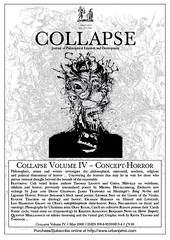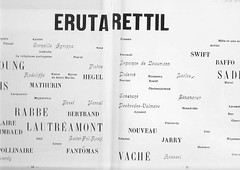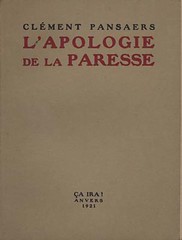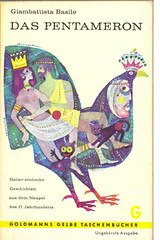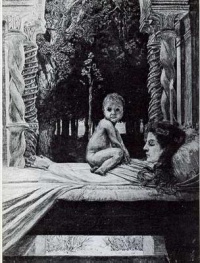Aimé Fernand David Césaire (25 June 1913 – 17 April 2008) was a French poet, author and politician. He was with Léopold Sédar Senghor one of the figure heads of the négritude movement, the precursor to the Black Power movement of the 1960s. His writings reflect his passion for civic and social engagement. He is the author of Discours sur le colonialisme (Discourse on Colonialism) (1953), a denunciation of European colonial racism which was published in the French review Présence Africaine. In 1968, he published the first version of Une Tempête, a radical adaptation of Shakespeare’s play The Tempest for a black audience.
Category Archives: literature
Contemporary philosophy
Collapse IV (2008)
Order it here.
This looks interesting. Nice cover too. A bit arcimboldesque. I wonder who did it. This is the cover of a contemporary philosophy magazine of which this issue is dedicated to the theory of horror. Any philosophy of horror and the representation thereof (which is also the theory of the aestheticization of violence) needs to start with Aristotle, as I’ve stated before. Aristotle said on the subject:
“Objects which in themselves we view with pain, we delight to contemplate when reproduced with minute fidelity: such as the forms of the most ignoble animals and of dead bodies.” —Aristotle from the Poetics.
As you may have guessed by now, I have limited first-hand knowledge on some subjects; I do not have the patience to read Aristotle. Nevertheless, in my infinite ignorance, I dare to state that I like Aristotle and dislike Plato. Plato strikes me as a bore (much like Kant does), Aristotle was a sensationalist like myself. From “my” page on aestheticization of violence, Plato comes across as the sort of moral crusader I’ve never felt any sympathy for (except that they have sometimes pointed me in the direction of worthwhile art, see the censor/censored dilemma):
Plato proposed to ban poets from his ideal republic because he feared that their aesthetic ability to construct attractive narratives about immoral behavior would corrupt young minds. Plato’s writings refer to poetry as a kind of rhetoric, whose “…influence is pervasive and often harmful.” Plato believed that poetry that was “unregulated by philosophy is a danger to soul and community.” He warned that tragic poetry can produce “a disordered psychic regime or constitution” by inducing “a dream-like, uncritical state in which we lose ourselves in …sorrow, grief, anger, [and] resentment.
Back to contemporary philosophy. From Wikpedia:
“Philosophy has re-entered popular culture through the work of authors such as Alain de Botton. This trend is reinforced by the recent increase in films with philosophical content. Some films, such as Fight Club, eXistenZ, The Matrix trilogy, Little Miss Sunshine, and Waking Life have philosophical themes underpinning their overarching plots. Other films attempt to be overtly philosophical, such as I ♥ Huckabees.”
I’ve done Fight Club, eXistenZ, The Matrix and Little Miss Sunshine and of those three I like eXistenZ best. I will want to see Waking Life and I ♥ Huckabees. Where do I start. Huckabees? It stars Huppert. And from what I’ve Youtubed of Waking, it reminded me of Scanner Darkly, with which I was not too impressed (but has lingered on afterwards). Any thoughts, dear readers?
Update 17/4: More on Collapse. Collapse has links with New Weird and Speculative realism. The cover is probably by the Chapmans (“new etchings from Jake Chapman“). Of all its contributions I am most curious about Graham Harman on the unnatural bond between Husserl and Lovecraft and Iain Hamilton Grant on Lorenz Oken‘s naturphilosophische slime-horror.
Cult fiction #4
Horror Panegyric is a 2008 book by Keith Seward which looks at the Lord Horror stories published by Savoy Books (David Britton and Michael Butterworth). The cover design is by British illustrator John Coulthart.
Lord Horror is the most recent work of literature after Last Exit to Brooklyn to be banned in England and obliged Britton to serve a term in a British prison.
Colin Wilson, in a review of the Lord Horror series remarked:
“I think that, as an exercise in Surrealism, Lord Horror compares with some of the best work that came out of France and Germany between the wars, for example Georges Bataille. The book has some brilliantly funny passages, particularly about Old Shatterhand. Britton is undoubtedly brilliant, but when I came to the bit about Horror hollowing out a Jewess’s foot and putting it over his penis, I started skipping. With the best will in the world, I couldn’t give his brilliant passages the attention they deserve because I kept being put off by this note of violence and sadism. No doubt it is because I belong to an older generation that is still basically a bit Victorian.”
Tip of the hat to Paul Rumsey.
Erutarettil, or, Treasures from the Antwerp library
I went to the Permeke library in the center of Antwerp yesterday evening and loaned these:
- Les Symbolistes (Serge Baudiffier; Jean-Marc Debenedetti , 1990)
- Sade / Surreal
- Ghislaine Wood’s Art Nouveau and the Erotic
- Owen S. Rachleff ‘s The Occult in Art
- William Rubin ‘s Primitivism in 20th Century Art
Two of these books I had already loaned, the work by Rachleff, which is excellent, and the sublime Sade / Surreal, which I’ve mentioned before here. Sade/Surreal is a pricey book (a French bookseller currently wants more than 300 EUR for it, but a German vendor is currently letting it go for less than 40 Euros, which is a bargain, if you have deep pockets, consider buying it for me as a present). For the last hour of so, I’ve been updating my wiki with the names found on the opening and closing pages of the book (pictured below), which reads like a who’s who of Sadean thought, a summa sadeica, as it were.
Opening and closing page of Sade/Surreal
There were only a couple of names I could not identify, any help is welcome: Retz (either Gilles de Rais, or the cardinal with the same name, Young (perhaps Mr. Young of Night Thoughts?), de Saint Martin, Bertrand (probably Aloysius Bertrand ?) and Constant (Constantin Meunier?). The rest is indentified.
Also in the same book is the engraving below, which I find lovely, like a cake-building or a building of collapsing blubbery wet clay.
Tomb of Pompeii by Jean-Baptiste Tierce, 1766
American academics down on their knees kissing French bums
I am re-reading Sex, Art, and American Culture by Paglia after my brother salvaged a copy from the dustbin. It must have been 4 years since I first read it and I understand a lot more. The vehement attack on “French theory” now surprises me in the sense that she mainly focuses on Foucault, Derrida and Baudrillard without mentioning what are imo the truly great French theorists: Barthes, Deleuze, Bataille. I know from a Salon q&a[1] that she doesn’t even like Bataille. Really! Re-read him Camille! In that short 1997 q&a she notes that she “was deeply disappointed in Bataille from the moment I picked up his books. His themes are my themes, his influences (in many cases) my influences.” She does confess to like Sade, Gautier, Balzac, Baudelaire, Huysmans, Sartre (whom I find difficult to stomach), de Beauvoir, Genet and Bachelard.
Of course her style is offensive (and I suspect it has had some re-writing in subsequent editions). As a European I find the following derogatory remarks on the French post-wwii-climate difficult to swallow (but funny anyhoo):
- “Of course the French felt decentered: they had just been crushed by Germany. American G.I.’s (including my uncles) got shot up rescuing France when she was lying flat on her face under the Nazi boot. Hence it is revolting to see pampered American academics down on their knees kissing French bums.”
Nevertheless, Paglia strikes me time and time again as a great intellectual with an amount of books read which seems astronomical and a very astute power of analysis: how she equates Foucault’s taxonomy to Primitive Classification by Mauss and Durkheim and Foucault’s Discipline and Punish to Durkheim‘s The Division of Labour in Society.
This reading also brought Arnold Hauser‘s The Social History of Art to my attention.
Sex, Art, and American Culture is a sensible buy for someone who wants to brush up on cultural history from an irreverent but yet well-read perseptive.
On a different note, and only for a Dutch-reading public: the publication of Hermans-Reve correspondence is imminent. Hermans was brilliant and Reve a bit of a bore, at one point Hermans decided not to continue the correspondence. Read more at The Paper Man.
Towards a bibliography of laziness and sloth
- Paul Lafargue, The Right to Be Lazy
- Kazimir Malevich, “Laziness – the real truth of mankind“
- Clément Pansaers, L’Apologie de la paresse
- Samuel Johnson, The Idler
- Jerome K. Jerome, The Idler
Decameron, Pentameron, and Heptameron
Cover of a German edition of the Pentameron
Les Cent Nouvelles nouvelles also deserves mention here.
See also: Toward a Motif-Index of Erotic Humor
Cult fiction #3
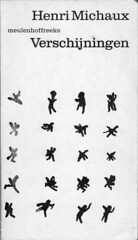
I started reading Verschijningen today, a Dutch translation of a selection of texts by Henri Michaux, published by Meulenhoff in 1972.
My first conscious exposure to the thought of Michaux was by way of David Toop‘s Ocean of Sound, in which Toop describes Michaux as an armchair traveler.
The collection comprises Les poètes voyagent (1946); Un certain Plume (1930); Apparitions (1946); Ici Poddema (1946); texts from Façons d’endormi, facons d’eveille; followed by a short essay by the translator Laurens Vancrevel.
My first impressions are based on reading Les poètes voyagent; Un certain Plume and Apparitions, Plume providing the most satisfying reading experience: the whole of Plume breathes Edgar Allan Poe and especially Poe’s incomparable short story Loss of Breath.
Keywords of Michaux’s writing are viscerality; the tropes of the macabre, fantastique, rocambolesque and grotesque; petrifaction, death, the void, lightness and emptiness, “everything-you-know-is-wrong” feelings, disintegration, decapitation and dismemberment, walls (and especially ceilings). All things considered, this is a very eerie collection told in a matter of fact voice.
If the content and tone are definitely Poe, the form of this collection’s most likely sibling is the writing of Baudelaire, and especially Baudelaire’s prose poetry.
The “liner notes” to this collection also alerted me to Images du monde visionnaire, a film by Eric Duvivier and Henri Michaux, an educational film which was produced in 1963 by the film department of Swiss pharmaceutical company Sandoz (best known for synthesizing LSD in 1938) in order to demonstrate the hallucinogenic effects of mescaline and hashish. It is the only venture in film of notable French writer and painter Henri Michaux. See that film by following the Documents entry, read more at Ombres Blanches.
Nobrow manifestos, #2
The Pornographic Imagination is is my second entry in this series, the first was Leslie Fiedler’s Cross the Border — Close the Gap (1969).
The Pornographic Imagination is a nobrow essay by Susan Sontag first published in book form in Styles of Radical Will. It had been originally published two years earlier in the Partisan Review of spring 1967.
The subject is erotic literature and Sontag contends that five French literary works are not ‘just’ pornography but literary fiction and thus genuine literature. Although the term paraliterature had not been coined at the time of its writing (we have to wait 17 years for Fredric Jameson to do that), the connection between science fiction and erotic fiction makes this essay one of the first defenses of the nobrow or paraliterary category.
Her ‘case’ is based on these five novels:
- L’Histoire d’O (1954) – Pauline Réage
- Histoire de l’oeil (1928) – Georges Bataille
- Madame Edwarda (1937) – Georges Bataille
- Trois filles de leur mère (1926) – Pierre Louÿs
- L’Image (1956) – Catherine Robbe-Grillet
On Georges Bataille she writes:
- “One reason that Histoire de l’oeil and Madame Edwarda make such a strong and unsettling impression is that Bataille understood more clearly than any other writer I know of that what pornography is really about, ultimately, isn’t sex but death. I am not suggesting that every pornographic work speaks, either overtly or covertly, of death. Only works dealing with that specific and sharpest inflection of the themes of lust, “the obscene,” do. It’s toward the gratifications of death, succeeding and surpassing those of eros, that every truly obscene quest tends.”
I CANNOT live without my life! I CANNOT live without my soul!
Dead Mother (1898) by Max Klinger
“May she wake in torment!’ he cried, with frightful vehemence, stamping his foot, and groaning in a sudden paroxysm of ungovernable passion. ‘Why, she’s a liar to the end! Where is she? Not THERE – not in heaven – not perished – where? Oh! you said you cared nothing for my sufferings! And I pray one prayer – I repeat it till my tongue stiffens – Catherine Earnshaw, may you not rest as long as I am living; you said I killed you – haunt me, then! The murdered DO haunt their murderers, I believe. I know that ghosts HAVE wandered on earth. Be with me always – take any form – drive me mad! only DO not leave me in this abyss, where I cannot find you! Oh, God! it is unutterable! I CANNOT live without my life! I CANNOT live without my soul!“
That’s the end of Wuthering Heights‘ Heathcliff‘s tirade against his faithless lover Catherine who has just died in childbirth, a speech which begins in anger and blasphemy and ends in beseechment and pleading, which epitomizes the love hate relationship between the two characters.
Wuthering Heights is Emily Brontë‘s only novel. The narrative tells the tale of the all-encompassing and passionate, yet thwarted love between Heathcliff and Catherine Earnshaw, and how this love hate relationship eventually destroys both themselves and many around them.


